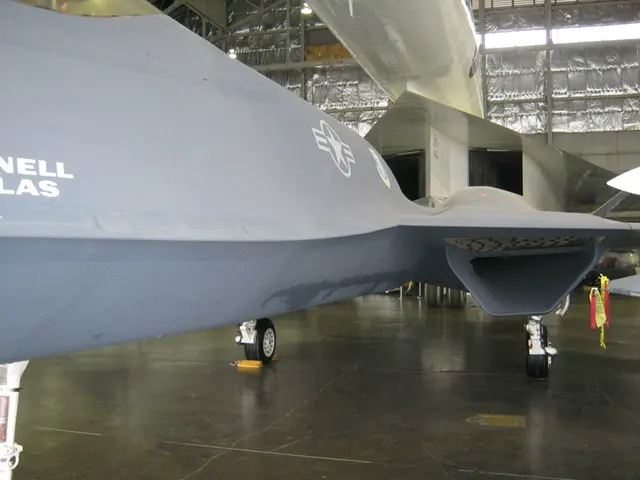Russia's air force suffered significant setback as Ukraine launched successful drone strikes against their warplanes, potentially weakening the Kremlin's strategic military capabilities.
Take a Sneak Peek at Russia's Strategic Bomber Fleet: Tu-95, Tu-22M, and Tu-160
In an unexpected turn of events, a series of drone attacks targeting key Russian air bases has sent shockwaves across the global military landscape. The audacious onslaught, initially targeting air bases hosting nuclear-capable strategic bombers, even managed to reach as far as Siberia, delivering a significant blow to the Russian military.
While the exact extent of the damage remains unclear, with conflicting claims from Ukraine and Russia, one thing is for certain—the attack demonstrated Ukraine's capability to strike high-value targets across Russian territory, dealing a humiliating blow to the Kremlin and inflicting substantial losses on Moscow's war machine.
In this rundown, we delve into the strategic bombers that have been central to Russia's military efforts, specifically the Tupolev Tu-95, Tu-22M, and Tu-160.
The Tupolev Tu-95 (NATO code name: Bear)
This four-engine turboprop plane, designed in the 1950s to rival the U.S. B-52 bomber, boasts an intercontinental range and can carry eight long-range cruise missiles, equipped with either conventional or nuclear warheads. Prior to the recent assault, Russia was estimated to have about 60 Tu-95s in its fleet. However, with the aftermath of the attack still under scrutiny, it remains unknown how many of these venerable aircraft have been lost.
The Tupolev Tu-22M (NATO code name: Backfire)
A twin-engine supersonic bomber, the Tu-22M was designed in the 1970s. Its shorter range compared to the Tu-95 doesn't detract from its strategic importance. During U.S.-Soviet arms control talks in the 1970s, Washington insisted on counting them as part of the Soviet strategic nuclear arsenal due to their potential to reach the U.S. if refueled in flight. The latest version, the Tu-22M3, carries Kh-22 cruise missiles that fly at over three times the speed of sound. Its outdated guidance system, however, could lead to inaccuracies when striking ground targets, raising the possibility of collateral damage.
Prior to the drone attack, Russia was believed to have between 50 and 60 Tu-22M3s in service.
The Tupolev Tu-160
Fewer than 20 of these supersonic bombers are in service, and Russia has only recently begun production of its modernized version equipped with new engines and avionics. Packing a punch with its supersonic speed and ability to carry 630 kilograms (approximately 1,400 pounds) of explosives, the Tu-160 is a valuable asset in Russia's strategic bomber fleet.
In the aftermath of the attack, experts estimate that Russia has lost a substantial part of its heavy bomber fleet, with no immediate means to replace it.
The A-50, an early warning and control aircraft similar to the U.S. AWACS planes used to coordinate aerial attacks, was also reportedly hit in the strikes. Any loss of this aircraft significantly impairs Russia's military capability.
As the dust settles from the attack, Russia will likely face the challenge of relocating its bombers to safer bases, while simultaneously trying to improve their protection from future attacks. The implementation of more robust shelters or hangars for these large aircraft will undoubtedly be a daunting task, as the military grapples with the reality of a new and evolving threat landscape.
Sources:
- BBC News. (2021, June 23). Russia says it repels Ukrainian drone attack on air bases. https://www.bbc.com/news/world-europe-57666636
- The Washington Post. (2021, June 23). Siberia bomber base reportedly hit in a group of Ukrainian drone attacks on Russia. https://www.washingtonpost.com/world/2021/06/23/siberia-bomber-base-reportedly-hit-group-ukrainian-drone-attacks-russia/
- Defense News. (2021, June 24). Analysis: Russian heavy bombers the biggest losers in Ukraine drone strikes. https://www.defensenews.com/global/mideast-africa/2021/06/24/analysis-russian-heavy-bombers-the-biggest-losers-in-ukraine-drone-strikes/
- Russian Aerospace Forces. (n.d.). Tu-160 strategic missile carrier. https://en.bomber.ru/index.php?option=com_content&view=article&id=106:tu-160&catid=43:military-aircraft&Itemid=102
- In Seattle, finance experts are closely watching the repercussions of the recent drone attacks on Russia's strategic bomber bases, as the losses could significantly impact Russia's aerospace industry.
- The attacks on Russia's Tu-95, Tu-22M, and Tu-160 bombers have raised concerns in political circles regarding the stability of the global military balance and the potential for escalation in war-and-conflicts involving Russia.
- General news outlets are reporting increased military tensions between Ukraine and Russia, with the destruction of key Russian air bases housing strategic bombers becoming a focal point in the ongoing conflict, impacting industries across the globe, including finance, aerospace, and politics.






